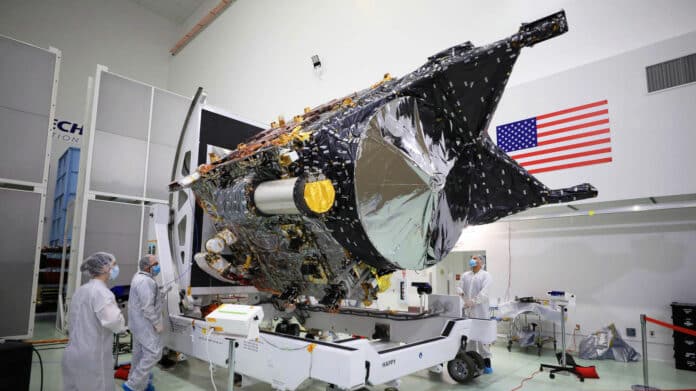NASA‘s Deep Space Optical Comm (DSOC) is the latest in a series of optical communication demonstrations. It is the agency’s first optical communications demonstration beyond the Earth-Moon system.
Now, the experiment has achieved ‘first light,’ sending data via laser to and from far beyond the Moon for the first time.
The Hale Telescope at Caltech’s Palomar Observatory in San Diego County, California, has been targeted by the experiment with a near-infrared laser encoded with test data from almost 10 million miles (16 million kilometers) away, or roughly 40 times farther than the Moon is from Earth. This is the optical communications demonstration at its furthest point to date.
In the wee hours of November 14, the technology demonstration attained “first light” when its flight laser transceiver—an advanced device on board Psyche that can transmit and receive near-infrared signals. As the automatic mechanisms on the transceiver and ground stations adjusted its pointing, the uplink beacon assisted the transceiver in aiming its downlink laser back to Palomar, which is located 100 miles (or 130 kilometers) south of Table Mountain.
Trudy Kortes, director of Technology Demonstrations at NASA Headquarters in Washington, said, “Achieving first light is one of many critical DSOC milestones in the coming months, paving the way toward higher-data-rate communications capable of sending scientific information, high-definition imagery, and streaming video in support of humanity’s next giant leap: sending humans to Mars.”
One of the main goals of the experiment was to “close the link” by sending test data simultaneously across the uplink and downlink lasers. Although the technology demonstration isn’t sending data from the Psyche mission, it collaborates closely with the mission-support team to ensure DSOC operations don’t conflict with spacecraft operations.
Meera Srinivasan, operations lead for DSOC at JPL, said, “Tuesday morning’s test was the first to fully incorporate the ground assets and flight transceiver, requiring the DSOC and Psyche operations teams to work in tandem. It was a formidable challenge, and we have a lot more work to do, but for a short time, we could transmit, receive, and decode some data.”
After a successful first light, the DSOC team will focus on improving the technologies that regulate the downlink laser’s pointing within the transceiver. After this is accomplished, the team can demonstrate how to continue transmitting high-bandwidth data from the transceiver to Palomar at different Earthly distances.
This data is encoded in bits, the smallest data units that a computer can handle, and is found in the photons of light, which are quantum particles produced by the laser. The data is extracted from the single photons that arrive at the Hale Telescope using innovative signal-processing techniques after a unique superconducting high-efficiency detector array detects the photons.
Dr. Jason Mitchell, director of the Advanced Communications and Navigation Technologies Division within NASA’s Space Communications and Navigation (SCaN) program, said, “Optical communication is a boon for scientists and researchers who always want more from their space missions and will enable human exploration of deep space. More data means more discoveries.”
Abi Biswas, project technologist for DSOC at JPL, said, “Achieving first light is a tremendous achievement. The ground systems successfully detected the deep space laser photons from DSOC’s flight transceiver aboard Psyche. And we were also able to send some data, meaning we were able to exchange ‘bits of light’ from and to deep space.”
